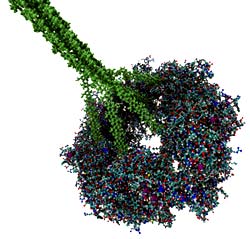Plant Protein Shape Puzzle Solved by Molecular 3-D Model

The 3-D molecular model of a plant cellulose synthase no longer remains elusive.<br>
In a groundbreaking paper published online this week in Proceedings of the National Academy of Sciences, the researchers provide the first three-dimensional model of an enzyme that links a simple sugar, glucose, into long-chain cellulose, the basic building block within plant cell walls that gives plants structure. Cellulose is nature’s most abundant renewable biomaterial and an important resource for production of biofuels that represent alternatives to fossil fuels.
New understanding of the structure of the modeled plant enzyme, a cellulose synthase, may allow researchers to genetically engineer plants and trees for better cotton fibers or stronger wood, for example. From a materials engineering perspective, the findings can also be used to create beneficial nanocrystals with desired properties and functions.
“This structural model gives us insight into how cellulose synthesis works,” said Dr. Yaroslava Yingling, an NC State materials science and engineering professor who is the corresponding author on the study. “In the long term, it could result in new genetically modified plants that can be tweaked to induce specific engineered properties of cellulose.”
The study examined the structure of one cellulose synthase found in cotton fibers. The researchers compared their model with the structure of a similar enzyme in bacteria and found that the proteins were similarly folded in key regions required for cellulose synthesis. In the lab rat of the plant family – Arabidopsis thaliana, or mustard weed – the researchers identified potential causes for defective cellulose synthesis in mutant plants by making analogies to the modeled cotton cellulose synthase.
“Without the enzyme structure, you can’t make strategically designed, rational projections about how to make beneficial changes to the proteins – but now you can,” said Dr. Candace Haigler, an NC State crop scientist and plant biologist who co-authored the study. “In the future we could make cellulose easier to break down into biofuels while ensuring that the plants themselves are able to grow well.”
Latsavongsakda Sethaphong, an NC State doctoral student, co-authored the study, as did researchers from Penn State University, the University of Virginia, the University of Ontario Institute of Technology and the University of Kentucky. The computational research was supported as part of The Center for LignoCellulose Structure and Formation, an Energy Frontier Research Center funded by the U.S. Department of Energy, Office of Science.
– kulikowski –
Note to editors: An abstract of the paper follows.
Tertiary Model of a Plant Cellulose Synthase
Authors: Latsavongsakda Sethaphong, Candace H. Haigler and Yaroslava G. Yingling, North Carolina State University; James D. Kubicki, Penn State University; Jochen Zimmer, University of Virginia; Dario Bonetta, University of Ontario Institute of Technology; Seth DeBolt, University of Kentucky
Published: Online April 15, 2013, in Proceedings of the National Academy of Sciences
Abstract: A three-dimensional atomistic model of a plant cellulose synthase (CESA) has remained elusive despite over forty years of experimental effort. Here we report a computationally predicted three dimensional structure of 506 amino acids of cotton CESA within the cytosolic region. Comparison of the predicted plant CESA structure with the solved structure of a bacterial cellulose-synthesizing protein validates the overall fold of the modeled glycosyltransferase (GT) domain. The co-aligned plant and bacterial GT domains share a six-stranded ß-sheet, five ?-helices, and conserved motifs similar to those required for catalysis in other GT-2 glycosyltransferases. Extending beyond the cross-kingdom similarities related to cellulose polymerization, the predicted structure of cotton CESA reveals that plant specific modules (‘plant conserved region’, P-CR, and ‘class specific region’, CSR) fold into distinct subdomains on the periphery of the catalytic region. Computational results support the importance of the P-CR and/or CSR in CESA oligomerization to form the multimeric cellulose-synthesis complexes that are characteristic of plants. Relatively high sequence conservation between plant CESAs allowed mapping of known mutations and two novel mutations that perturb cellulose synthesis in Arabidopsis thaliana to their analogous positions in the modeled structure. Most of these mutations sites are near the predicted catalytic region, and the confluence of other mutation sites supports the existence of previously undefined functional nodes within the catalytic core of CESA. Overall, the predicted tertiary structure provides a platform for the biochemical engineering of plant CESAs.
Media Contact
More Information:
http://www.ncsu.eduAll latest news from the category: Life Sciences and Chemistry
Articles and reports from the Life Sciences and chemistry area deal with applied and basic research into modern biology, chemistry and human medicine.
Valuable information can be found on a range of life sciences fields including bacteriology, biochemistry, bionics, bioinformatics, biophysics, biotechnology, genetics, geobotany, human biology, marine biology, microbiology, molecular biology, cellular biology, zoology, bioinorganic chemistry, microchemistry and environmental chemistry.
Newest articles

Superradiant atoms could push the boundaries of how precisely time can be measured
Superradiant atoms can help us measure time more precisely than ever. In a new study, researchers from the University of Copenhagen present a new method for measuring the time interval,…

Ion thermoelectric conversion devices for near room temperature
The electrode sheet of the thermoelectric device consists of ionic hydrogel, which is sandwiched between the electrodes to form, and the Prussian blue on the electrode undergoes a redox reaction…

Zap Energy achieves 37-million-degree temperatures in a compact device
New publication reports record electron temperatures for a small-scale, sheared-flow-stabilized Z-pinch fusion device. In the nine decades since humans first produced fusion reactions, only a few fusion technologies have demonstrated…





















